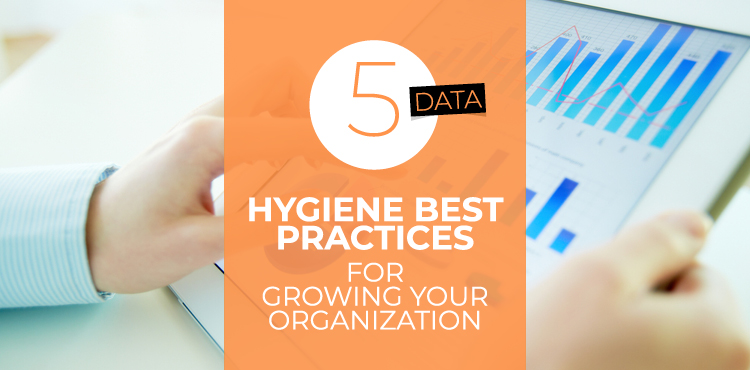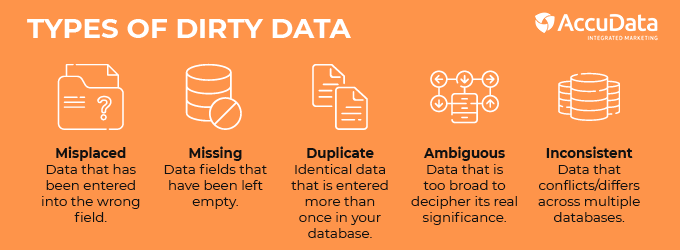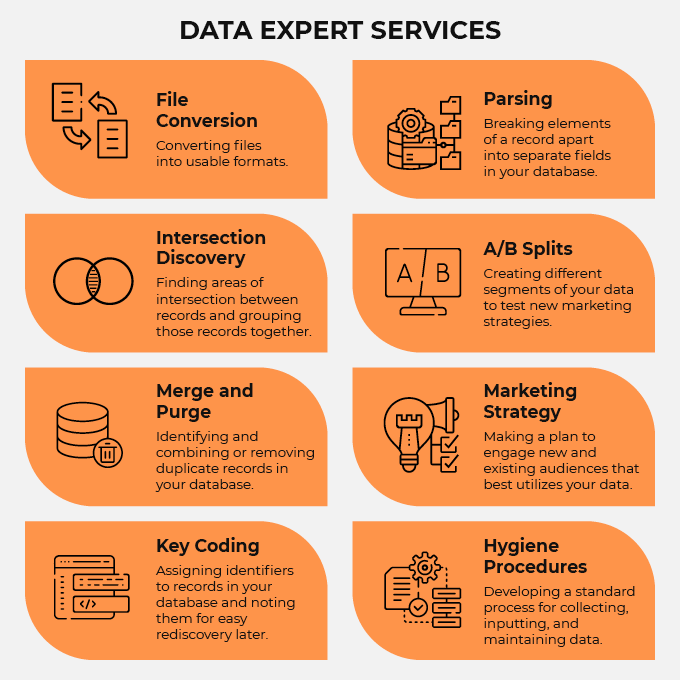
Did you know that the key to stronger, more efficient marketing (and therefore, growing your nonprofit organization in return) is an asset already in your arsenal? We’re talking about data and the many ways you can use it for more effective outreach.
However, before you can even think about using your data to grow your audience, you must first ensure it’s clean, accurate, and up-to-date. Data hygiene is the practice of cleaning your database to remove inaccurate or otherwise unhelpful information. It’s a combination of large database sweeps and ongoing maintenance.
Often, when we talk about data hygiene, we focus on the pitfalls of “dirty” data — data that’s misplaced, missing, duplicate, ambiguous, or inconsistent.
Yes, dirty data contained in your CRM solution can have a severely harmful effect on your ability to achieve your mission. But data hygiene isn’t just a necessary chore. It’s a positive step that we can take to boost fundraising efforts, broaden outreach, and increase supporter engagement and retention.
In this guide, we’re going to explore the top five tips to keep your organization’s database in check and help you make the most of your data. When revisiting your data hygiene practices, make sure to:
- Begin with an audit of your current database.
- Suppress unhelpful and hurtful information.
- Examine your database with a detail-oriented mindset.
- Create processes to collect, enter, and house only essential data.
- Work with a team of data management experts.
With data at your fingertips, you have the ability to unlock the door to expanding your audience and with it, your organization — but only if your data are well maintained.
Begin with an audit of your current database.
We know that data can be invaluable when it comes to guiding your decision-making. In order to make the best choices for your organization, you need to ensure the data you’re relying on is accurate and complete. That’s where data hygiene comes into play.
If you’ve never explored data hygiene before, you’re likely going to need to begin with one large clean-up.
While human error probably accounts for some of your database errors — who hasn’t mistyped their email address at least once? — technology may also be a hidden culprit. In the nonprofit sector, your programs are aided by a vast number of technologies. Between your corporate giving tools, fundraising solutions, and prospect research software, you’re swimming in an overwhelming sea of data.
The good news is that so much data gives your organization a lot to work with! But in order to make the best possible data-driven decisions, you’ll need to first decide what’s important and what’s clouding your view.
So, begin by diving into your database and conducting a full audit. With this audit, aim to get a high-level overview of your database’s health. Which data points are necessary, and which are not? Which areas of your database contain the most inaccuracies? Are there inconsistencies in how you’ve input names and addresses over the years? Are there missing data points that could be skewing the way you target potential donors? Are there gaps in your data that could help you enter a new market?
In performing your data audit, be sure to determine which data points your organization will actually use to make decisions and which ones are just extraneous information.
After going through this audit, share your findings with all parties involved. Once everyone’s on board, you can then begin cleaning your database.
Suppress unhelpful and hurtful information.
While it may seem intuitive to collect as much data as possible — after all, the argument in this piece is that data can have a major positive impact on your operational efficiency — it’s also entirely possible to have too much data.
After your audit, the next step of effective data hygiene involves suppressing data that can directly work against your organization’s efforts. You’ll want to suppress unusable information from your database so your efforts lead to actionable insights. This includes:
- People on Do Not Mail listings. DMAChoice is a service created for consumers by the Association of National Advertisers that allows consumers to place their names on an official Do Not Mail classification. If supporters have indicated that they don’t want to receive mail from your organization, you should honor those wishes. Remove these addresses from any of your direct mail-related databases.
- People on Do Not Call listings. Similar to DMAChoice, the National Do Not Call Registry was created for consumers that don’t want to receive telephone solicitations. Remove these phone numbers from any marketing lists you are managing.
- Incarcerated individuals. When a person is incarcerated in state, federal, county correctional, or city facilities, they’re unable to respond to your marketing initiatives. Suppress their information to prevent wasted marketing dollars.
- Minors. Making direct marketing appeals to children can result in fines from the FTC, so ensure any minors (children under 18) and their contact information is suppressed in your database.
- Deceased individuals. Suppress the information of individuals that are now deceased, preventing sending information to their family members and wasting your marketing dollars.
As this AccuData article shows, data-based marketing can drastically improve your outreach efforts. Removing these sets of information ensures that you’re only sending communications to those who will be interested and able to respond.
Examine your database with a detail-oriented mindset.
Beyond removing unhelpful and harmful data, there’s another aspect of data hygiene: fixing incorrect data.
Whether a single missed keystroke, a data migration gone awry, or even an incorrectly copied-and-pasted line of text due to a foggy brain, it’s incredibly easy to introduce errors into your database. While it may not seem like a huge issue, a single error can lead to you sending outreach to an incorrect address or to the wrong supporter. As you plan a marketing or fundraising strategy, you’ll want to make sure that you can implement it efficiently and effectively.
When doing your initial clean-up, examine your database with a fine-toothed comb. Look for:
- Duplicate entries. For example, was a donor recorded twice, with a slightly different spelling? It’s crucial that you combine and remove duplicates that have slipped through the cracks due to slightly incorrect, or nonstandard, information. You want to avoid flooding an inbox with the same message — again — and again — and again.
- Nonstandard entries. For instance, are some addresses coded as “Road” while others are “Rd.”? Ensure that all of your addresses (being mindful of the CASS certification system), numbers, titles, and other common areas of dissonance are standardized. As you reach out to your audience, addressing them with the right title and name will make them more likely to support your cause.
- Non-verifiable entries. If you’re unable to verify an email or phone number, there’s a decent chance it’s incorrect. This results in communications bouncing back to you, so you’ll also want to remove those entries.
You want to ensure that the information in your database is accurate, so you can confidently make decisions using it.
Create processes to collect, enter, and house only essential data.
After you’ve completed an audit of your database, suppressed unhelpful information, and fixed incorrect entries, your database will be in great shape. But, how long will it remain in that state?
We’ve already discussed how your digital efforts are continuously generating tons of data — whether you’re collecting donations and handling payment processing through your website or sending out regular email drip campaign communications. This means that in little time, you could have an overwhelming, cluttered database to clean up again!
Your data hygiene goals are to avoid these major clean-ups as much as possible. One way to do so is to be mindful of the data you’re entering into your database in the first place.
Aim to only collect and house data that you truly plan to utilize. However, this could be different for different organizations, so it’s important to dive into your own goals to determine what will be useful.
Alongside your plan for what data to house, develop a standard process for how to collect, enter, and maintain that data. As a best practice, you’ll want to:
- Standardize data entry. Delineate the format for how each data point is entered into your CRM and train your staff on these best practices. While it may take some time at the outset, this will save you time and energy in the long-run.
- Create rules for how to handle future errors. Instruct staff on how to handle duplicate, incorrect, and incomplete entries. For example: Decide how you’ll address contacts in the same household. By grouping individuals with the same address, you can better personalize your messaging.
- Streamline your client-facing forms. When donors and volunteers input their own information (i.e. via an online survey) they can introduce new errors into your system. Streamlining these forms with clear instructions and conditional logic that can ask different questions depending on each response, will make it easier on both you and them.
- Back-up your data. Make sure to schedule regular back-ups and to set a back-up before making any changes. Because it’s the most important step of any process, we feel the need to say it twice: Back-up your data!
That being said, there may also be times when you find you need more data. For example, in addition to basic contact information, a nonprofit may choose to add third-party wealth screening data, such as philanthropic history or net worth, that can help them filter for the donors most likely to make large gifts, and allocate their major gift outreach resources accordingly.
With a defined plan and process, you can collect only the data that will best benefit your organization and best target your nonprofit’s valuable and limited resources.
Work with a team of data management experts.
While data hygiene is essential, that doesn’t necessarily mean it’s simple! Diving into a database and making changes with confidence, without displacing or disrupting key information, can be a challenge for even the most experienced of nonprofit leaders.
Luckily, there are consultants that can create data hygiene procedures and help your organization analyze this data for optimal marketing results. You can learn about these experts in AccuData’s guide to data and marketing analytics companies. Generally, they can accomplish a number of hygiene tasks including:
- File Conversion: Converting files into usable formats.
- Intersection Discovery: Finding areas of intersection where separate records have intersecting points (ex: a shared address)and group those records together.
- Merge and Purge: Identifying and combining or removing duplicate records from your database.
- Key Coding: Assigning identifiers to records in your database and noting them for easy rediscovery later.
- Parsing: Breaking elements of a record apart into separate fields in your database.
- A/B Splits: Creating different segments of your data to test new marketing strategies.
In addition to completing specific hygiene tasks, these teams can also help your organization create new hygiene procedures, develop a marketing strategy, and carry that strategy to build an audience or generate new leads.
If your organization is looking to grow through supporter acquisition and believes data are the key to doing so, a team of data experts can be a valuable resource.
With powerful marketing, your nonprofit can expand its audience and strengthen its programs. The most effective way to improve your marketing efforts is to dive into your data, cleaning up your organization’s greatest asset to use it for impactful outreach. With these tips, you’ll be off to a great start.
This post was contributed by Gabrielle Perham, MBA, Director of Marketing at AccuData.
Gabrielle is the Director of Marketing for AccuData Integrated Marketing. She joined the organization in 2017 and possesses more than 15 years of experience in strategic marketing, branding, communications, and digital marketing. She earned a B.S. in Marketing and an M.B.A in Marketing Management from the University of Tampa.







